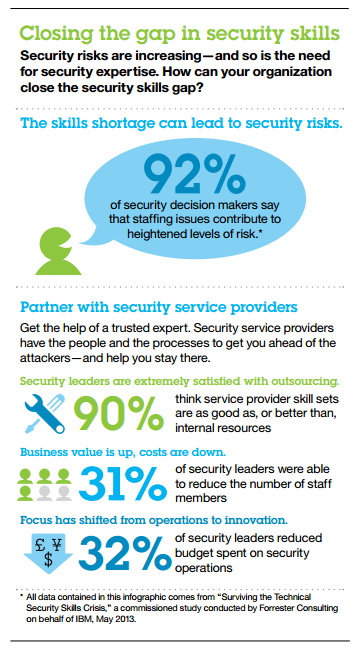Now, organizations can consume only the technology resources they need without the overhead of acquiring and managing their own infrastructure. They can significantly lower capital expenses (because there is no need for large, one-time purchases of technology). Plus, they can rapidly adapt to changing business needs at almost infinite scale.
 Ensuring Cloud Security
Ensuring Cloud Security
As cloud adoption increases, organizations are also more focused than ever on ensuring that strong security controls are in place. In a recent IBM survey, 75 percent of security leaders expected their cloud security budget to increase or increase dramatically over the next three to five years.2 (David Jarvis, “Gaining the Confidence to Fly: Cloud Insights From the 2014 IBM CISO Assessment,” IBM Security Intelligence blog) By taking a phased approach to cloud-based security, organizations can be fiscally responsible about shifting their budgets, and take their time in evaluating vendors.
Naturally, the security industry has responded with a wide range of offerings to help organizations reap all the rewards of the cloud—and reduce security risks. Finding the right solution, can be a task. Here’s what to look for.
The right security intelligence tools can:
- Reduce a large number of security events to a small number of offenses requiring action
- Decrease false positives
- Tell security teams what has been exploited and what kind of activity has taken place as a result (such as data loss, theft or fraud)
- Provide quicker detection and incident response
Finding the Right Vendor
The right cloud vendor will enable organizations to make the most of their on-premises investments, delivering the experienced people and best practices to meet specific security needs. As a first step to cloud-hosted security, the vendor should empower in-house security teams with the advanced correlation and analysis capabilities of security information and event management (SIEM). This way, IT staff can understand the context of threats, prioritize risks and vulnerabilities, and take the right steps for forensic investigations, remediation and mitigation. Then, after building trust with the vendor, they can move to a fully outsourced solution—integrating IaaS, SaaS, data analysis and other managed security services.
With the right vendor, cloud-hosted security can meet these specific needs
- Organizations can rely on security experts to acquire the right infrastructure.
- Solutions can be deployed with less time and effort than on-premises technology.
- Skilled staff can manage service availability and health monitoring.
- Software upgrades and patches are kept up-t o- date for effective protection.
- Cloud capacity can be upgraded at any time to handle changing business needs.
- SIEM capabilities can be customized for different environments, including rule tuning, reporting and dashboards.
Schedule a consultation today to learn how Flagship can help you design and implement an effective cloud security solution.
If you liked this blog, you also might like: Simplifying Patch Management


